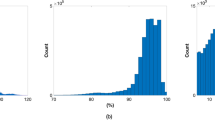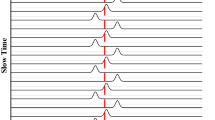Abstract
To assess a non-contact method to determine the physical alteration of human subjects confined behind a barrier or under disaster rubble, an experimental, non-contact monitoring system was tested on rabbits in a hypovolaemic state. New Zealand male rabbits behind a barrier were subjected to hypovolaemic shock induced by the withdrawal of arterial blood (2ml per 100g body weight). The hypovolaemic state was determined by linear discriminant analysis using non-contact-derived variables: heart rate X1 and respiratory rate X2. Sixteen rabbits were equally divided between the hypovolaemic and control groups. To obtain the heart and respiratory rates simultaneously, the fast Fourier transform (FFT) was performed on the 1215MHz microwave radar analogue output. The linear discriminant function calculated by non-contact-derived variables was negative in the eight hypovolaemic rabbits and positive in the eight controls, so that the linear discriminant function could distinguish the hypovolaemic group from the control group. The Mahalanobis D-square (an index for classification accuracy) was 5908; the classification error rate corresponding to this value was small and negligible. The hypovolaemic rabbits developed metabolic acidosis (HCO3 − 18.6±11.1mmoll−1 and pH 7.15±0.18 in arterial blood). The systolic blood pressure of the hypovolaemic group and the control was 56±4 and 83±6 mmHg, respectively (p<0.01). The proposed method appears promising for applications to monitor the condition of human subjects behind barriers or under disaster rubble.
Similar content being viewed by others
References
Arai, I. (2001): ‘Survivor search radar system for persons trapped under earthquake rubble’.Asia-Pacific Microwave Conf., Taipei, WE3D
Chen, K. M., Misra, D., Wang, H., Chuang, H. R., andPostow, E. (1986): ‘An X-band microwave life-detection system’,IEEE Trans. Biomed. Eng.,33, pp. 697–702
Chen, K. M., Huang, Y., andZhang, J. (2000): ‘Microwave life-detection systems for searching human subjects under earthquake rubble or behind barrier’,IEEE Trans. Biomed. Eng.,27, pp. 105–113
Dunham, C. M., Belzberg, H., Lyles, R., Weireter, L., Skurdal, D., Sullivan, G., Esposito, T., andNamini, M. (1991): ‘The rapid infusion system: a superior method for the resuscitation of hypovolaemic trauma patients’,Resuscitation,21, pp. 207–227
Deakin, C. D. (1994): ‘Early fluid resuscitation in haemorrhagic shock’,Eur. J. Emerg. Med.,1, pp. 83–85
Fox, R. H., andSolman, A. J. (1971): ‘A new technique for monitoring the deep body temperature in man from the intact skin surface’,J. Physiol.,212, pp. 8–10
Kikuchi, M., Ishihara, M., Matsui, T., Sato, S., Ashida, H., andIshizuka, T. (2004): ‘Biomedical engineering contribution to defending the homeland, technological and biomedical initiatives being taken in Japan to counter bioterrorism’,IEEE Eng. Med. Biol.,23, pp. 175–186
Lynn, M., Jeroukhimov, I., Klein, Y., andMartinowitz, U. (2002): ‘Updates in the management of severe coagulopathy in trauma patients’,Intensive Care. Med.,2, pp. S241-S247
Matsukawa, T., Kashimoto, S., Ozaki, M., Shindo, S., andKumazawa, T. (1996): ‘Temperatures measured by a deep body thermometer (Coretemp) compared with tissue temperatures measured at various depths using needles placed into the sole of the foot’,Eur. J. Anaesthesiol.,13, pp. 340–345
Matsui, T., Hagisawa, K., Ishizuka, T., Matsumura, K., Ishihara, M., Sato, S., Takase, B., Suzuki, M., Kikuchi, M., andKurita, A. (2002): ‘The development of a continuous temperature mapping system using a deep body thermometer’,J. Med. Eng. Technol.,26, pp. 123–125
Matsui, T., Ishizuka, T., Ishihara, M., Ishihara, M., Matsumura, K., Kikuchi, M., andKurita, A. (2003): ‘The non-contact monitoring of heart and respiratory rates using laser irradiation: an experimental simultaneous monitoring with and without clothes during biochemical hazards’,J. Med. Eng. Technol.,27, pp. 133–136
Matsui, T., Hagisawa, K., Ishizuka, T., Takase, B., Ishihara, M., Kikuchi, M. (2004): ‘A novel method to prevent secondary exposure of medical and rescue personnel to toxic materials under biochemical hazard conditions using microwave radar and infrared thermography’,IEEE Trans. Biomed. Eng. (in press)
Schupp, M., Swanevelder, J. L. C., Peek, G. J., Sosnowski, A. W., andSpyt, T. J. (2003): ‘Postoperative extracorporeal membrane oxygenation for severe intraoperative SIRS 10h after multiple trauma’,Br. J. Anaesth.,90, pp. 91–94
Tsuji, T. (1987): ‘Patient monitoring during and after open heart surgery by an improved deep body thermometer’,Med. Prog. Technol., pp. 1225–1238
Yoshimoto, Y., Tanaka, Y., andHoya, K. (2001): ‘Acute systemic inflammatory response syndrome in subarachnoid hemorrhage’,Stroke,9, pp. 1989–1993
Author information
Authors and Affiliations
Corresponding author
Rights and permissions
About this article
Cite this article
Matsui, T., Ishizuka, T., Takase, B. et al. Non-contact determination of vital sign alterations in hypovolaemic states induced by massive haemorrhage: An experimental attempt to monitor the condition of injured persons behind barriers or under disaster rubble. Med. Biol. Eng. Comput. 42, 807–811 (2004). https://doi.org/10.1007/BF02345214
Received:
Accepted:
Issue Date:
DOI: https://doi.org/10.1007/BF02345214




